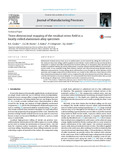JavaScript is disabled for your browser. Some features of this site may not work without it.
| dc.contributor.author | Coules, Harry E. | |
| dc.contributor.author | Horne, G. C. M. | |
| dc.contributor.author | Kabra, S. | |
| dc.contributor.author | Colegrove, Paul A. | |
| dc.contributor.author | Smith, D. J. | |
| dc.date.accessioned | 2017-05-31T07:29:32Z | |
| dc.date.available | 2017-05-31T07:29:32Z | |
| dc.date.issued | 2017-03-08 | |
| dc.identifier.citation | Coules HE, Horne GCM, Kabra S, et al., (2017) Three-dimensional mapping of the residual stress field in a locally rolled aluminium alloy specimen. Journal of Manufacturing Processes, Volume 26, April 2017, pp. 240-251 | en_UK |
| dc.identifier.issn | 1526-6125 | |
| dc.identifier.uri | http://dx.doi.org/10.1016/j.jmapro.2017.02.010 | |
| dc.identifier.uri | https://dspace.lib.cranfield.ac.uk/handle/1826/11939 | |
| dc.description.abstract | Detrimental residual stresses that occur in welded joints can be removed by rolling the weld seam. In this study we show that rolling could be applied to much thicker-section welds than has previously been attempted. A residual stress field introduced by localised rolling of an aluminium alloy specimen was studied to establish whether the plastic deformation caused by rolling would be sufficient to treat thick-section welds. It was modelled using finite element analysis and characterised using detailed neutron diffraction measurements. During rolling, plastic deformation occurs through the entire thickness of the specimen and strongly compressive residual stresses are created in the rolled area. Some features of the three-dimensional residual stress field, such as a region of tensile stress beyond the end of the rolled area, could be detrimental to structural integrity. It is recommended that these should be taken into account in the design of rolling-based weld treatment and surface treatment processes. | en_UK |
| dc.language.iso | en | en_UK |
| dc.publisher | Elsevier | en_UK |
| dc.rights | Attribution 4.0 International (CC BY 4.0) You are free to: Share — copy and redistribute the material in any medium or format, Adapt — remix, transform, and build upon the material for any purpose, even commercially. The licensor cannot revoke these freedoms as long as you follow the license terms. Under the following terms: Attribution — You must give appropriate credit, provide a link to the license, and indicate if changes were made. You may do so in any reasonable manner, but not in any way that suggests the licensor endorses you or your use. Information: No additional restrictions — You may not apply legal terms or technological measures that legally restrict others from doing anything the license permits. | |
| dc.subject | Residual stress | en_UK |
| dc.subject | Neutron diffraction | en_UK |
| dc.subject | Finite element analysis | en_UK |
| dc.subject | Rolling | en_UK |
| dc.subject | Welding | en_UK |
| dc.title | Three-dimensional mapping of the residual stress field in a locally rolled aluminium alloy specimen | en_UK |
| dc.type | Article | en_UK |
Files in this item
This item appears in the following Collection(s)
-
Staff publications (SATM) [4365]
